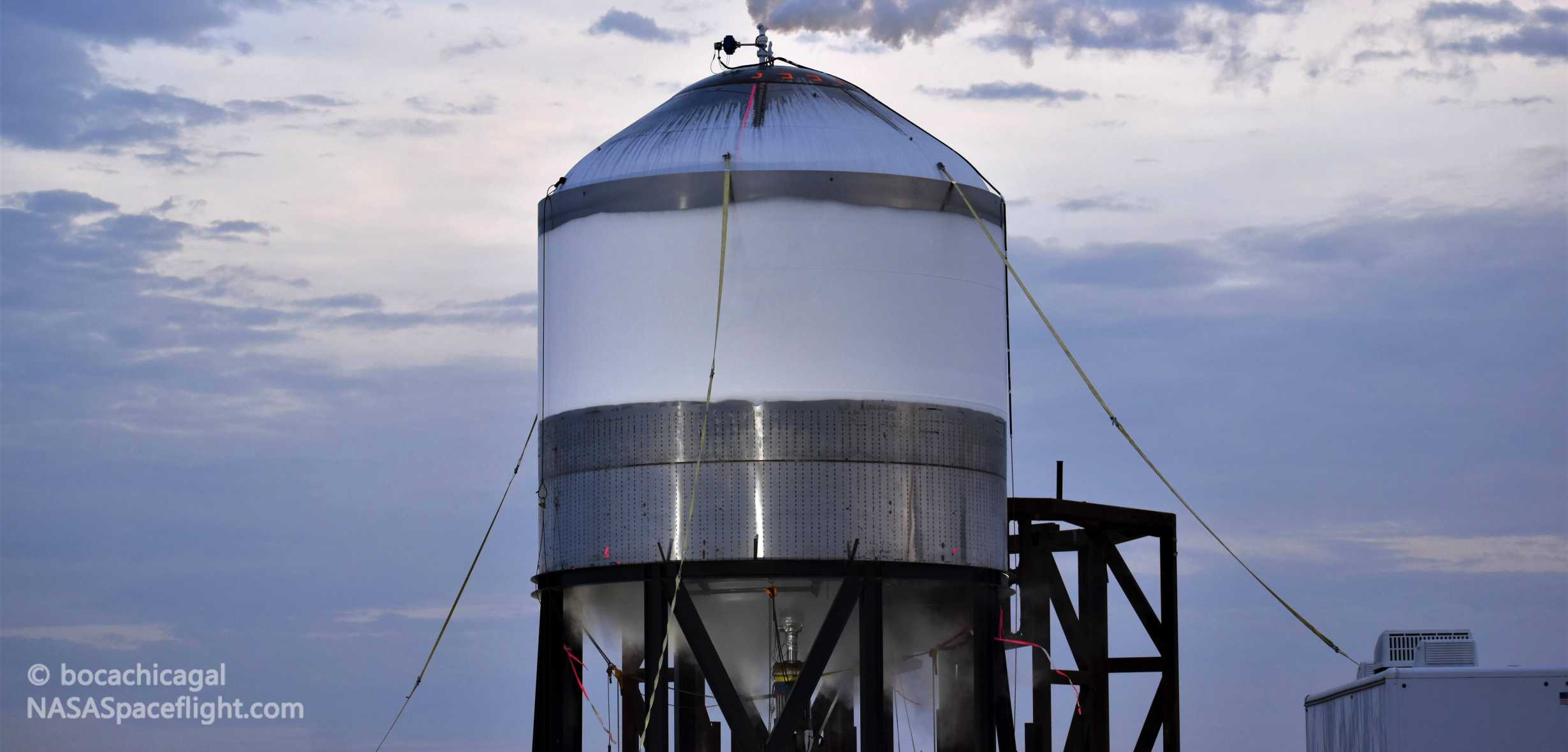
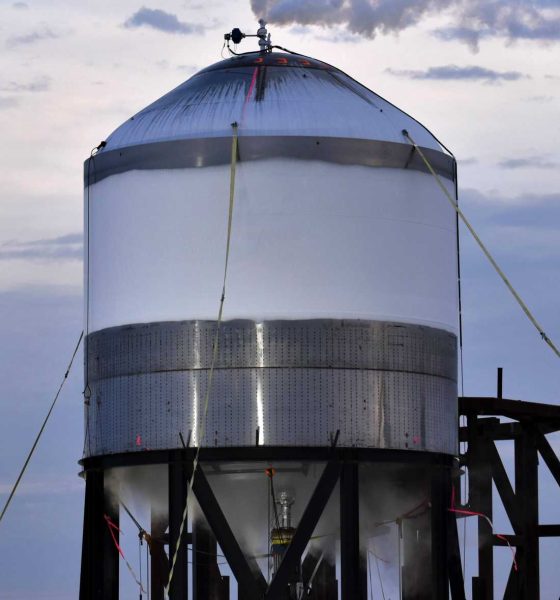
News
SpaceX returns to Starship program roots with new ‘test tank’ prototype
It’s now clear that SpaceX is preparing to return to the roots of its Starship program with the latest in a series of one-off ‘test tanks’ meant to qualify upgrades to the rocket’s design and production.
Likely known as Starship SN7.2, the hardware will be the first standalone tank built and tested by SpaceX since SN7.1 was successfully pressurized to failure in a process known as burst testing in September 2020. Following in the footsteps of SN7.1, a simple test tank fully focused on qualifying a change in the steel alloy used to build Starships, SN7.2 was somewhat more complex, swapping one of two smooth forward domes with a thrust dome and adding a ‘skirt’ section.
Built out of the same steel alloy as SN7.1, SN7.2 went through similar testing but included the use of a hydraulic ram designed to simulate the thrust of one, two, or three Raptors on the ‘thrust puck’ those engines would otherwise attach to. Starship test tank SN7.2 appears to be quite similar to SN7.1 – but with one or two crucial differences.
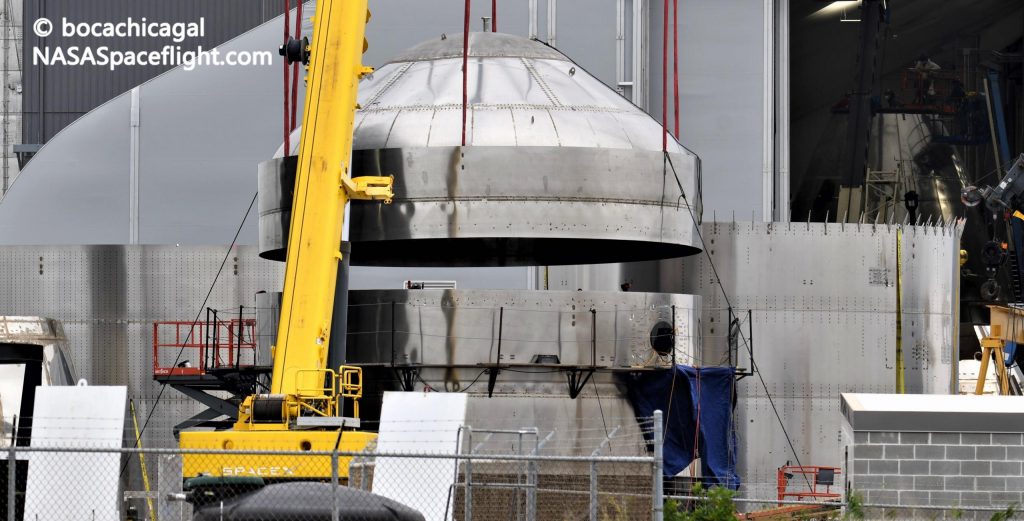
The first difference, as noted above, is a reduction in the thickness of the steel rings that make up the outer walls and structure of SN7.2’s barrel-like tank section. SpaceX is believed to have reduced that skin thickness by 25% (4mm to 3mm) in an apparent effort to begin a weight reduction process necessary for Starships to eventually achieve their optimal payload goal of ~150 metric tons (~330,000 lb) to low Earth orbit.
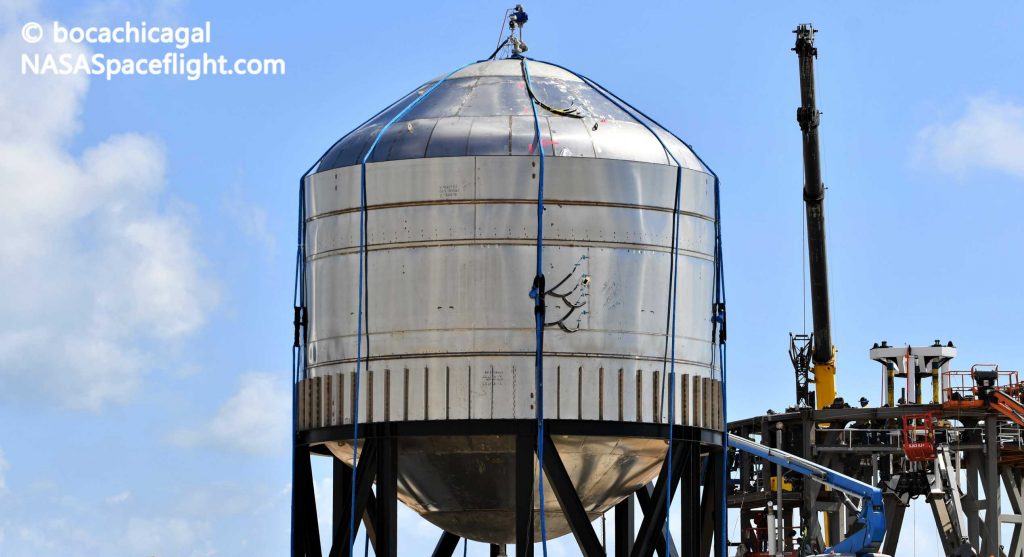
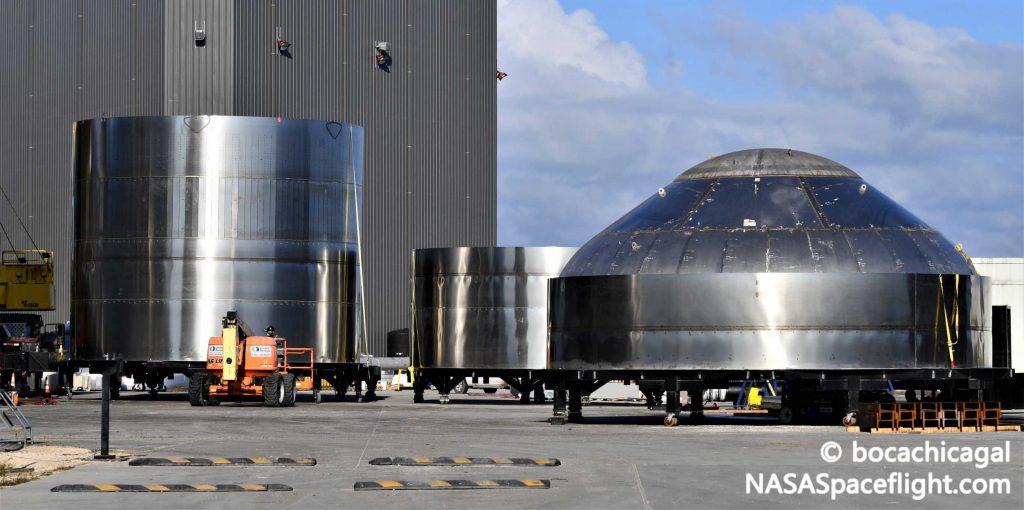
From some angles, SN7.2’s steel rings do appear slightly flimsier or more liable to warp from the heat of welding than other test tanks in the SN7 range, but the differences are rather subtle. Regardless, a reduction from 4mm to 3mm steel rings could likely cut 5-10% from an orbit-capable Starship’s empty weight. When every gram of Starship mass reduction translates directly into an extra gram of payload, it’s safe to say that SpaceX is just getting started.
It’s unclear if a successful SN7.2 test campaign will result in similar reductions to the steel that makes up Starship tank domes and noses. SN7.2’s forward and thrust domes appear to be more or less identical to almost all prior Starship prototype hardware.
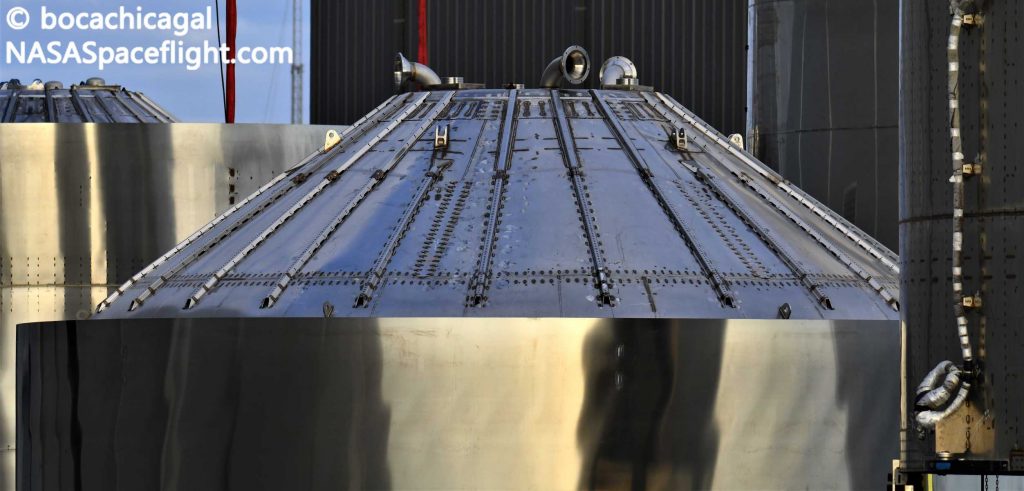
Aside from thinner steel skin, it’s also possible that SpaceX will attempt to hit two birds with one stone and test a second unproven change on SN7.2 – namely an upgraded ‘thrust puck’ design. That new puck design first appeared on a November 2020 shipment from SpaceX’s Hawthorne, CA headquarters. Referring to the cone-like structure Starship’s three central Raptor engines attach to and are fed propellant through, the new design simplifies plumbing complexity by allowing Starship’s fuel and fuel header tanks to attach directly to and feed methane through the puck.
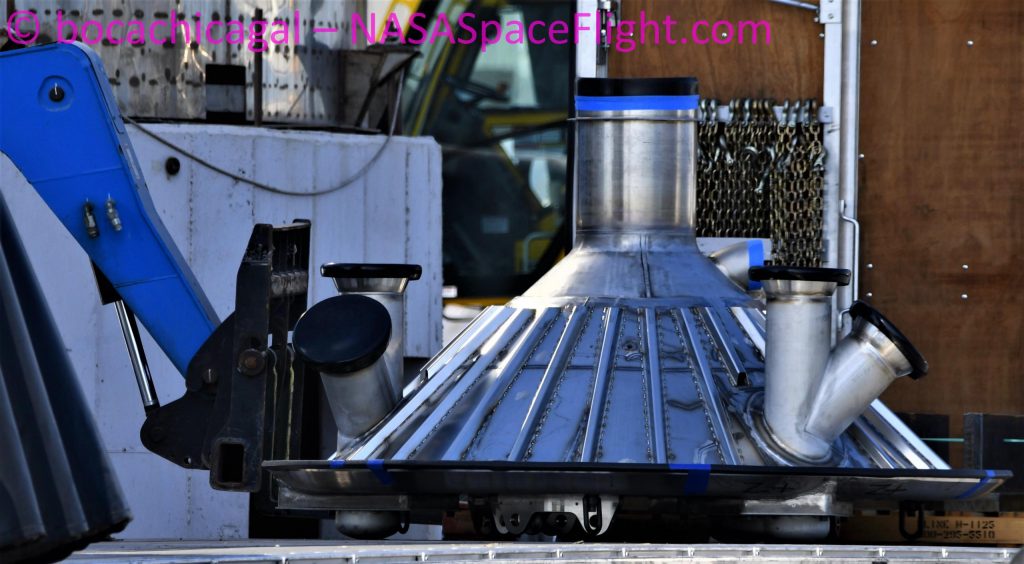

It’s unclear which thrust puck design SN7.2 has settled on, though SpaceX’s decision to make SN7.2 an engine section test tank arguably points towards the new puck. Regardless, SpaceX will almost certainly install a skirt section – two reinforced rings – underneath SN7.2 once the tank is welded together, giving it the hold-down clamps needed to secure it to a launch mount while simulating Raptor thrust.

News
Tesla FSD fleet is nearing 7 billion total miles, including 2.5 billion city miles
As can be seen on Tesla’s official FSD webpage, vehicles equipped with the system have now navigated over 6.99 billion miles.

Tesla’s Full Self-Driving (Supervised) fleet is closing in on almost 7 billion total miles driven, as per data posted by the company on its official FSD webpage.
These figures hint at the massive scale of data fueling Tesla’s rapid FSD improvements, which have been quite notable as of late.
FSD mileage milestones
As can be seen on Tesla’s official FSD webpage, vehicles equipped with the system have now navigated over 6.99 billion miles. Tesla owner and avid FSD tester Whole Mars Catalog also shared a screenshot indicating that from the nearly 7 billion miles traveled by the FSD fleet, more than 2.5 billion miles were driven inside cities.
City miles are particularly valuable for complex urban scenarios like unprotected turns, pedestrian interactions, and traffic lights. This is also the difference-maker for FSD, as only complex solutions, such as Waymo’s self-driving taxis, operate similarly on inner-city streets. And even then, incidents such as the San Francisco blackouts have proven challenging for sensor-rich vehicles like Waymos.
Tesla’s data edge
Tesla has a number of advantages in the autonomous vehicle sector, one of which is the size of its fleet and the number of vehicles training FSD on real-world roads. Tesla’s nearly 7 billion FSD miles then allow the company to roll out updates that make its vehicles behave like they are being driven by experienced drivers, even if they are operating on their own.
So notable are Tesla’s improvements to FSD that NVIDIA Director of Robotics Jim Fan, after experiencing FSD v14, noted that the system is the first AI that passes what he described as a “Physical Turing Test.”
“Despite knowing exactly how robot learning works, I still find it magical watching the steering wheel turn by itself. First it feels surreal, next it becomes routine. Then, like the smartphone, taking it away actively hurts. This is how humanity gets rewired and glued to god-like technologies,” Fan wrote in a post on X.
News
Tesla starts showing how FSD will change lives in Europe
Local officials tested the system on narrow country roads and were impressed by FSD’s smooth, human-like driving, with some calling the service a game-changer for everyday life in areas that are far from urban centers.

Tesla has launched Europe’s first public shuttle service using Full Self-Driving (Supervised) in the rural Eifelkreis Bitburg-Prüm region of Germany, demonstrating how the technology can restore independence and mobility for people who struggle with limited transport options.
Local officials tested the system on narrow country roads and were impressed by FSD’s smooth, human-like driving, with some calling the service a game-changer for everyday life in areas that are far from urban centers.
Officials see real impact on rural residents
Arzfeld Mayor Johannes Kuhl and District Administrator Andreas Kruppert personally tested the Tesla shuttle service. This allowed them to see just how well FSD navigated winding lanes and rural roads confidently. Kruppert said, “Autonomous driving sounds like science fiction to many, but we simply see here that it works totally well in rural regions too.” Kuhl, for his part, also noted that FSD “feels like a very experienced driver.”
The pilot complements the area’s “Citizen Bus” program, which provides on-demand rides for elderly residents who can no longer drive themselves. Tesla Europe shared a video of a demonstration of the service, highlighting how FSD gives people their freedom back, even in places where public transport is not as prevalent.
What the Ministry for Economic Affairs and Transport says
Rhineland-Palatinate’s Minister Daniela Schmitt supported the project, praising the collaboration that made this “first of its kind in Europe” possible. As per the ministry, the rural rollout for the service shows FSD’s potential beyond major cities, and it delivers tangible benefits like grocery runs, doctor visits, and social connections for isolated residents.
“Reliable and flexible mobility is especially vital in rural areas. With the launch of a shuttle service using self-driving vehicles (FSD supervised) by Tesla in the Eifelkreis Bitburg-Prüm, an innovative pilot project is now getting underway that complements local community bus services. It is the first project of its kind in Europe.
“The result is a real gain for rural mobility: greater accessibility, more flexibility and tangible benefits for everyday life. A strong signal for innovation, cooperation and future-oriented mobility beyond urban centers,” the ministry wrote in a LinkedIn post.
News
Tesla China quietly posts Robotaxi-related job listing
Tesla China is currently seeking a Low Voltage Electrical Engineer to work on circuit board design for the company’s autonomous vehicles.

Tesla has posted a new job listing in Shanghai explicitly tied to its Robotaxi program, fueling speculation that the company is preparing to launch its dedicated autonomous ride-hailing service in China.
As noted in the listing, Tesla China is currently seeking a Low Voltage Electrical Engineer to work on circuit board design for the company’s autonomous vehicles.
Robotaxi-specific role
The listing, which was shared on social media platform X by industry watcher @tslaming, suggested that Tesla China is looking to fill the role urgently. The job listing itself specifically mentions that the person hired for the role will be working on the Low Voltage Hardware team, which would design the circuit boards that would serve as the nervous system of the Robotaxi.
Key tasks for the role, as indicated in the job listing, include collaboration with PCB layout, firmware, mechanical, program management, and validation teams, among other responsibilities. The role is based in Shanghai.
China Robotaxi launch
China represents a massive potential market for robotaxis, with its dense urban centers and supportive policies in select cities. Tesla has limited permission to roll out FSD in the country, though despite this, its vehicles have been hailed as among the best in the market when it comes to autonomous features. So far, at least, it appears that China supports Tesla’s FSD and Robotaxi rollout.
This was hinted at in November, when Tesla brought the Cybercab to the 8th China International Import Expo (CIIE) in Shanghai, marking the first time that the autonomous two-seater was brought to the Asia-Pacific region. The vehicle, despite not having a release date in China, received a significant amount of interest among the event’s attendees.








